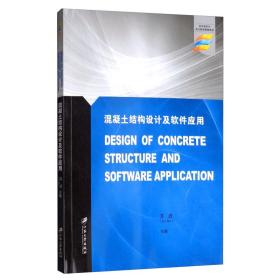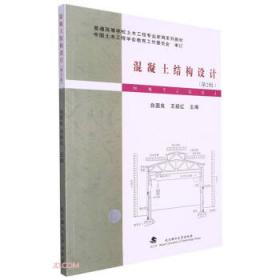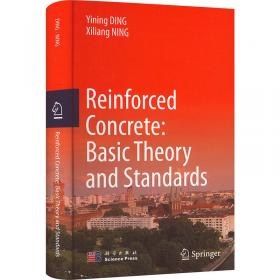混凝土结构设计及软件应用
出版时间:
2019-12
版次:
1
ISBN:
9787568410267
定价:
45.00
装帧:
平装
开本:
16开
纸张:
胶版纸
页数:
184页
-
《混凝土结构设计及软件应用》详细介绍了混凝土结构及软件设计的相关知识,共分为五章,包括概论、梁板结构、单层工业厂房、框架结构、设计软件应用案例。其中,第五章的软件采用国际通用建筑设计软件ETABS。该书着眼于学生实践能力,强调学生对知识点的理解、规范应用及实用工程设计能力的培养,着重培养学生综合运用知识及计算机软件进行工程设计的能力。 Chapter 1 Principles of Structural Design
1.1 Introduction
1.1.1 Structural Forms
1.1.2 Concrete Type
1.1.3 Objectives of Building Structural Design
1.1.4 Structural System
1.2 Loads
1.2.1 Loads Categories
1.2.2 Representative Values of Loads
1.2.3 Permanent Load
1.2.4 Live Loads
1.2.5 Wind Load
1.3 Material
1.3.1 Concrete
1.3.2 Steel Reinforcements
1.4 Structural Design Theory
1.4.1 Limit States Design
1.4.2 Load Combinations
1.5 The Design Process
1.5.1 Definis Client's Needs and Priorities
1.5.2 Develop Project Concept
1.5.3 Design Individual Systems
References
Questions
Chapter 2 Slabs
2.1 Introduction
2.1.1 Types of Floor Systems
2.1.2 Size of Reinforced Concrete Slabs
2.2 Design of One-Way Ribbed Slab
2.2.1 Structure Layouts of One-Way Slab
2.2.2 Calculating Diagram of One-Way Slab
2.2.3 Internal Forces Analysis by Elastic Theory Method
2.2.4 Internal Forces Analysis by Plastic Theory Method
2.2.5 Section Design and Reinforcements Construction of One-Way Slabs
2.3 Design of Two-Way Ribbed Slab
2.3.1 Structure Layouts of Two-Way Ribbed Slab
2.3.2 Stress Characteristics of Two way Ribbed Slab
2.3.3 Analysis of Two-Way Slab's Internal Forces by Elastic Theory Method
2.3.4 Internal Forces Analysis of Two Way Slab using the
Plastic Theory Method
2.3.5 Internal Force Analysis of Two-Way Slab Beam
2.3.6 Section Design and Construction Requirement of Two-Way Slab
2.3.7 Other Floor Types
2.3.8 Platform Slab of a Workshop
2.4 Stairs
2.4.1 Slab Stairs
2.4.2 Beam Stairs
References
Questions
Chapter 3 Single-Storey Factory Building
3.1 Introduction
3.2 Structural System and Design of Single-Layer Factory Buildings
3.2 . 1 Structure System
3.2.2 Layout of Structure Members
3.3 Internal Force Calculation of Bent Frame Structure
3.3.1 Assumptions and Calculations
3.3.2 Standard Load Values of Bent Frame Structure
3.3.3 Internal Force Analysis
3.3.4 Space Effect in Internal Force Analysis of Single
Storey Bent Frame Structure
3.3.5 Internal Force Combination
3.4 Bent Frame Column of Single-Storey Factory
3.4.1 Column Form
3.4.2 Design of Bent Frame Column
3.5 Design of Crane Beam
3.5.1 Mechanical Characteristics of Crane Beam
3.5.2 Selection of Crane Beam
3.5.3 Internal Force Calculation of Crane Beam
References
Questions
Chapter 4 Multilayer Frame Structures
4.1 Frame Construction Types and Layout
4.1.1 Features and Types of Frame Structures
4.1.2 Structure Layouts
4.1.3 Structure Form Selection and Section Dimension
Estimating
4.2 Internal Force and Displacement Calculation
4.2.1 Analysis Models
4.2.2 Internal Force Analysis under Vertical Loads
4.2.3 Internal Force Analysis under Horizontal Loads
4.2.4 Calculation of Displacement and the Limit Value of Frames
4.3 The Most Unfavourable Position of Load Combination
4.3.1 Control Sections
4.3.2 Load Effect Combination
4.3.3 Most Unfavorable Position under Vertical Variable Loads
4.3.4 Moment Amplitude Modulation of Beam End
4.4 Design of Frame Structural Components
4.4.1 Design of Frame Beam and Column
4.4.2 Design of Frame Joints
4.4.3 Frame Construction Requirements
References
Questions
Chapter 5 Application of Software
5.1 Introduction of Softwares
5.1.1 Introduction of Chinese Softwares
5.1.2 Introduction of International Softwares
5.2 Example: Design of a Reinforced Concrete Structure
5.2.1 Introduction of Project
5.2.2 BeginaNew Model
5.2.3 Add Floor Openings
5.2.4 Add Walls
5.2.5 Define Static Load Patterns
5.2.6 Review Diaphragms
5.2.7 Review the Load Cases
5.2.8 Run the Analysis
5.2.9 Display the Results
5.2.10 Design the Concrete Frames
5.2.11 Design the Shear Walls
References
Appendix
Appendix A
Appendix B
Appendix C
Appendix D
-
内容简介:
《混凝土结构设计及软件应用》详细介绍了混凝土结构及软件设计的相关知识,共分为五章,包括概论、梁板结构、单层工业厂房、框架结构、设计软件应用案例。其中,第五章的软件采用国际通用建筑设计软件ETABS。该书着眼于学生实践能力,强调学生对知识点的理解、规范应用及实用工程设计能力的培养,着重培养学生综合运用知识及计算机软件进行工程设计的能力。
-
目录:
Chapter 1 Principles of Structural Design
1.1 Introduction
1.1.1 Structural Forms
1.1.2 Concrete Type
1.1.3 Objectives of Building Structural Design
1.1.4 Structural System
1.2 Loads
1.2.1 Loads Categories
1.2.2 Representative Values of Loads
1.2.3 Permanent Load
1.2.4 Live Loads
1.2.5 Wind Load
1.3 Material
1.3.1 Concrete
1.3.2 Steel Reinforcements
1.4 Structural Design Theory
1.4.1 Limit States Design
1.4.2 Load Combinations
1.5 The Design Process
1.5.1 Definis Client's Needs and Priorities
1.5.2 Develop Project Concept
1.5.3 Design Individual Systems
References
Questions
Chapter 2 Slabs
2.1 Introduction
2.1.1 Types of Floor Systems
2.1.2 Size of Reinforced Concrete Slabs
2.2 Design of One-Way Ribbed Slab
2.2.1 Structure Layouts of One-Way Slab
2.2.2 Calculating Diagram of One-Way Slab
2.2.3 Internal Forces Analysis by Elastic Theory Method
2.2.4 Internal Forces Analysis by Plastic Theory Method
2.2.5 Section Design and Reinforcements Construction of One-Way Slabs
2.3 Design of Two-Way Ribbed Slab
2.3.1 Structure Layouts of Two-Way Ribbed Slab
2.3.2 Stress Characteristics of Two way Ribbed Slab
2.3.3 Analysis of Two-Way Slab's Internal Forces by Elastic Theory Method
2.3.4 Internal Forces Analysis of Two Way Slab using the
Plastic Theory Method
2.3.5 Internal Force Analysis of Two-Way Slab Beam
2.3.6 Section Design and Construction Requirement of Two-Way Slab
2.3.7 Other Floor Types
2.3.8 Platform Slab of a Workshop
2.4 Stairs
2.4.1 Slab Stairs
2.4.2 Beam Stairs
References
Questions
Chapter 3 Single-Storey Factory Building
3.1 Introduction
3.2 Structural System and Design of Single-Layer Factory Buildings
3.2 . 1 Structure System
3.2.2 Layout of Structure Members
3.3 Internal Force Calculation of Bent Frame Structure
3.3.1 Assumptions and Calculations
3.3.2 Standard Load Values of Bent Frame Structure
3.3.3 Internal Force Analysis
3.3.4 Space Effect in Internal Force Analysis of Single
Storey Bent Frame Structure
3.3.5 Internal Force Combination
3.4 Bent Frame Column of Single-Storey Factory
3.4.1 Column Form
3.4.2 Design of Bent Frame Column
3.5 Design of Crane Beam
3.5.1 Mechanical Characteristics of Crane Beam
3.5.2 Selection of Crane Beam
3.5.3 Internal Force Calculation of Crane Beam
References
Questions
Chapter 4 Multilayer Frame Structures
4.1 Frame Construction Types and Layout
4.1.1 Features and Types of Frame Structures
4.1.2 Structure Layouts
4.1.3 Structure Form Selection and Section Dimension
Estimating
4.2 Internal Force and Displacement Calculation
4.2.1 Analysis Models
4.2.2 Internal Force Analysis under Vertical Loads
4.2.3 Internal Force Analysis under Horizontal Loads
4.2.4 Calculation of Displacement and the Limit Value of Frames
4.3 The Most Unfavourable Position of Load Combination
4.3.1 Control Sections
4.3.2 Load Effect Combination
4.3.3 Most Unfavorable Position under Vertical Variable Loads
4.3.4 Moment Amplitude Modulation of Beam End
4.4 Design of Frame Structural Components
4.4.1 Design of Frame Beam and Column
4.4.2 Design of Frame Joints
4.4.3 Frame Construction Requirements
References
Questions
Chapter 5 Application of Software
5.1 Introduction of Softwares
5.1.1 Introduction of Chinese Softwares
5.1.2 Introduction of International Softwares
5.2 Example: Design of a Reinforced Concrete Structure
5.2.1 Introduction of Project
5.2.2 BeginaNew Model
5.2.3 Add Floor Openings
5.2.4 Add Walls
5.2.5 Define Static Load Patterns
5.2.6 Review Diaphragms
5.2.7 Review the Load Cases
5.2.8 Run the Analysis
5.2.9 Display the Results
5.2.10 Design the Concrete Frames
5.2.11 Design the Shear Walls
References
Appendix
Appendix A
Appendix B
Appendix C
Appendix D
查看详情
-
全新
广东省广州市
平均发货10小时
成功完成率95.16%
-
全新
北京市西城区
平均发货16小时
成功完成率92.2%
-
全新
广东省广州市
平均发货17小时
成功完成率92.75%
-
全新
江苏省南京市
平均发货5小时
成功完成率98.52%
-
全新
北京市朝阳区
平均发货15小时
成功完成率81.75%
-
全新
北京市丰台区
平均发货7小时
成功完成率93.26%
-
全新
北京市通州区
平均发货13小时
成功完成率96.55%
-
全新
北京市房山区
平均发货6小时
成功完成率58.33%
-
全新
河北省保定市
平均发货34小时
成功完成率85.54%
-
九五品
-
全新
江苏省南京市
平均发货6小时
成功完成率96.6%
-
九品
北京市海淀区
平均发货23小时
成功完成率89.35%
-
全新
北京市丰台区
平均发货28小时
成功完成率86.63%
-
全新
浙江省嘉兴市
平均发货9小时
成功完成率95.48%
-
全新
江苏省南京市
平均发货4小时
成功完成率95.76%
-
全新
北京市海淀区
平均发货16小时
成功完成率88.75%
-
全新
北京市海淀区
平均发货9小时
成功完成率97.87%
-
全新
-
全新
广东省广州市
平均发货17小时
成功完成率93.67%
-
全新
四川省成都市
平均发货19小时
成功完成率81.13%
-
全新
天津市西青区
平均发货14小时
成功完成率90.84%
-
混凝土结构设计及软件应用
保证正版现货,二十四小时发货,下单前请咨询客服确认库存,按书名发货,图片仅供参考,按书名发货!!按书名发货!!按书名发货!!
九五品
北京市通州区
平均发货9小时
成功完成率91.82%
-
全新
北京市通州区
平均发货9小时
成功完成率94.8%
-
全新
广东省广州市
平均发货17小时
成功完成率94.75%
-
全新
广东省广州市
平均发货7小时
成功完成率94.3%
-
全新
北京市通州区
平均发货9小时
成功完成率89.14%
-
全新
-
全新
北京市海淀区
平均发货17小时
成功完成率90.11%
-
全新
江苏省南京市
平均发货13小时
成功完成率85.48%
-
全新
四川省成都市
平均发货10小时
成功完成率96.05%
-
全新
北京市西城区
平均发货12小时
成功完成率94.21%
-
全新
江苏省无锡市
平均发货9小时
成功完成率96.65%
-
全新
北京市房山区
平均发货9小时
成功完成率96.25%
-
全新
浙江省嘉兴市
平均发货10小时
成功完成率93.5%
-
全新
广东省广州市
平均发货7小时
成功完成率90.52%
-
全新
北京市房山区
平均发货10小时
成功完成率81.49%
-
全新
北京市房山区
平均发货10小时
成功完成率81.49%
-
全新
广东省广州市
平均发货9小时
成功完成率88.76%
-
混凝土结构设计及软件应用
正版库存一手书,品相视出版时间长短而定,自然成色,可开电子发票,图片由软件自动采集,以书名为准,不以图片不符售后!
全新
山东省泰安市
平均发货6小时
成功完成率90.74%
-
全新
山东省泰安市
平均发货8小时
成功完成率93.38%
-
全新
北京市丰台区
平均发货8小时
成功完成率96.08%
-
全新
河北省保定市
平均发货18小时
成功完成率83.11%
-
混凝土结构设计及软件应用
新华书店全新正版书籍。书名与图片不一致的,以书名为准。个别套装书为单本价格,详情请咨询客服下单。
全新
河北省沧州市
平均发货13小时
成功完成率78.03%
-
全新
河北省保定市
平均发货13小时
成功完成率100%
-
全新
北京市丰台区
平均发货26小时
成功完成率82.63%
-
全新
上海市浦东新区
平均发货21小时
成功完成率83.53%

 占位居中
占位居中


























































































